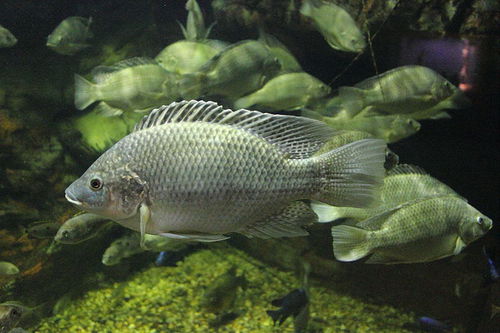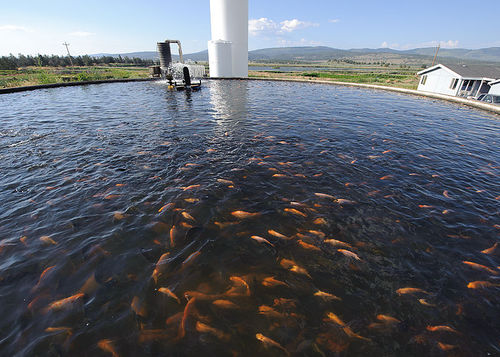Tilapia
General
- Nile tilapia grow to 9 lb and 9 years old - [1]
- Overview of integrated growing with duckweed and algae - [2]
- UFG design basics - [3]
Temperature
- Best temperature is 72-90F - [4]
PH
Tilapia likes high 7 low 8, plants like 5-6. Thus, compromise is neutral pH of 7.
- Vitamin c tablets - should work at 1 tablet for 55 gallons for 1 pH drop
Grow Beds
- 1:1 ratio - but of what? Volume tank to volume grow bed.
- 1 cubic foot of grow bed for every pound of tilapia - [7]
- 6-10 gallons of water for every square foot of deep (12") grow bed - [8]
- If we have an excess of water, then the limiting factor to the fish stocking is grow bed area. Now this will depend on other systems - such as duckweed
Duckweed Assist
- If duckweed is cultured in addition to plants, how much filtration does duckweed perform?
- Duckweed and watermeal on ponds - [9]
- possible additional filtration step: cattail pond or greenhouse
Growth Rate
- Exponential, linear, and plateau growth rates are the normal course of life of a tilapia. Depending on the genetics, the growth rate is linear up to from 1-3 lbs of weight. Linear phase starts at 100 grams, and before that, the rate of weight gain increases. - [10]
- It takes 6-12 months until harvest. - [11]
- 2% average growth rate of tilapia - [12], but .7% if fed duckweed alone - [13].
- 1-3% in linear stage - [14]
- Fish growth in lenght is linear, but weight gain is overall exponential in the general case - [15]
Price
Stocking Rate
- 1/4 lb per gallon without supplemental pure oxygen. With oxygen, stocking up to 1 lb per gallon is possible. -[18]. .25 lb per gallon means 250 lb per 1000 gallons, or 1000 lb per 4000 gallons.
- 5-9 lbs per cubic foot with oxygen - [19]. Same? 1 cubic foot = 7.5 gallons. Thi
- Bright Agrotech - correct stocking rate of 1 lb for 8-10 gallons of water - [20]. This rate allows for flow aearation, as opposed to air pump aeration - allowing the splash of flowing water to provide adequate oxygen. Summary: this figure is 1/2 or less the MSU publication above - so consistently conservative.
- 3 gallons to one pound of fish - [21]
- 1 lb per 5-10 gallons of water - [22]
- Thus - conservative estimate of 1 lb per 10 gallons of water - gets us 300 lb of fish mass sustainable stocking rate. 3 lb of fish per day assuming 1% growth rate.
Stocking Rate for Fry
- Southeast Asia stocking of fry - not adult carrying capacity of the water - .7 kg/m2 - [23] - if 1 meter deep, that is 264 gallons
Feeding
- In tilapia monoculture systems, animal manures stimulate phytoplankton which the tilapia feed on - [24]
- Tilapia can feed on duckweed alone with a 1:1 fish conversion ratio. Feed Conversion Ratio is best on duckweed alone, though the growth of the fish was half of that on a mixed diet. - [25]
- 1% of body weight feeding rate is recommended - [26]
- According to Tilapia Farming at Home, catfish food is OK for tilapia. Orscheln's has it for under 50 cents per pound - [27].
- Feeding with duckweed or azolla is not uncommon in aquaponics. This closes the nutrient cycle, because these plants thrive on wastewater from Tilapia cultivation.
- A diet 50/50 azolla/fish food is better for growth than commercial feed alone.
Toxic Food Sources
- If available, tilapia will also eat blue-green algae (cyanobacteria). Microcystins (a toxin released by cyanobacteria that is extremely harmful to humans and other animals) will accumulate in the fish's muscle tissue in quantities that may exceed the tolerable daily intake recommended by the WHO (0.04 μg/kg body weight/d)—see Algae for Tilapia and Are fish fed with cyanobacteria safe, nutritious and delicious? A laboratory study. Nile Tilapia may be used as an effective cyanobacteria filtration system for ponds and lakes.
Breeding
The OSE Aquaponic Greenhouse has two linear ponds, each 2000 gallons. They have submerged hydronic heaters, and a cloud of hundreds of fry appeared on 1/21/16 from the time that 7 adult fish were realeased on Nov. 15 - [28]. If they are in our tank, how to catch them and provide them as stock? This can be a revenue stream that we could advertise in the future if this process is streamlined.
With fry you need some predation and loss since they will breed hundreds, they keep them in their mouths for a few days so the real tiny ones are okay. Some people drop a clear plexiglass sheet about 1/3 of the way so that the little ones can swim by but when chased they can dodge behind the glass and the big ones soon learn that they cannot eat the little one. If it won't tear the plastic liner just isolate the new borns completely with a more tightly fit sheet--you want the big guys to see the little guys so they learn hands off. Make sure not to isolate the babies from their moms. ---

